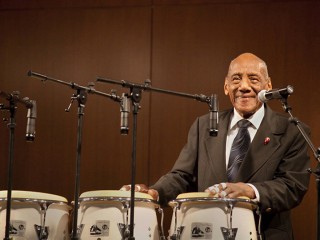
Candido Camero biography
Date of birth : 1921-04-22
Date of death : -
Birthplace : Havana, Cuba
Nationality : Cuban
Category : Arts and Entertainment
Last modified : 2011-07-06
Credited as : Jazz percussionist, conga and bongo player,
0 votes so far
Internationally celebrated as the man who essentially picked up where Chano Pozo left off, Candido Camero was among the most ubiquitous of the Cuban and Caribbean percussionists who enlivened and enriched the musical landscape of North America during the second half of the 20th century. Among the first to popularize the use of multiple conga drums and one of the inadvertent instigators of the bongo craze of the 1950s, he outlived most of his contemporaries and was still performing with extraordinary passion and precision well after attaining the status of an octogenarian.
As a young boy he played the string bass. After operating a tres guitar with Conjunto Gloria Habanera at the age of 14, he began to concentrate on the bongos, and had soon graduated to the conga. In addition to the Pan African combination of Yoruba, Portuguese, and Spanish folk influences, Candido named U.S. jazz drummers Max Roach and Kenny Clarke as primary inspirations. He recorded with various Cuban bandleaders including Machito, worked for six years in the house band at radio station CMQ in Havana, and performed at the Tropicana club there as a member of Armando Romeu's orquesta from 1947 to 1952.
The North American chapter of his career began in October of 1952 and was inaugurated with a six-week engagement at the Clover Club in Miami, followed by a move to New York suggested by his new friend, trumpeter Dizzy Gillespie, who personally took him to the Downbeat Club to sit in with pianist Billy Taylor. During 1953 and 1954 he recorded with Taylor's trio as well as with Erroll Garner, assisted Gillespie in the realization of "Manteca Suite" (the first of many recorded collaborations with Diz), and toured with the Stan Kenton Orchestra. He then formed his own group (including saxophonist Al Cohn); made his first recordings as a leader in 1956; and toured extensively through Venezuela, the Dominican Republic, Puerto Rico, Miami, and New York.
During the late '50s, throughout the '60s, and well into the '70s, Candido became the most active Latin American percussionist in both jazz and pop music, appearing on television to an unusual extent and recording with saxophonists Charlie Parker, Gene Ammons, Stan Getz, Phil Woods, Sonny Rollins, Illinois Jacquet, and Coleman Hawkins; guitarists Kenny Burrell and Wes Montgomery; pianists George Shearing and Marian McPartland; and vocalists Dinah Washington, Lena Horne, Patti Page, Tony Bennett, Charo, and Antonio Carlos Jobim. He appeared with bandleaders Tommy Dorsey, Duke Ellington, Woody Herman, Lionel Hampton, Doc Severinsen, Chico O'Farrill, Lalo Schifrin; drummer/bandleaders Art Blakey, Elvin Jones, Mongo Santamaria, and Tito Puente; and fellow conga masters Giovanni Hidalgo and Carlos "Patato" Valdes.
Over several decades he combined his highly developed Afro-Cuban artistry with disco, funk, and practically anything else that was in the air. With more than 16 albums to his credit (including a spectacular reunion with Machito's star vocalist Graciela Perez in 2004), a triumphant Candido sailed through the first years of the 21st century as resilient, creative, and full of life as ever. His signature line of premium drums come in three distinct models: the Quinto, the Conga, and the resonant Tumbadora.
Discography:
Candido (1956)
The Volcanic (1957 ABC-Paramount)
Latin Fire (1959)
Man of a Thousand Fingers (1969 Solid State)
Beautiful (1970 Blue Note)
Drum Fever (1973 Polydor)
Dancin' and Prancin' (1979 Salsoul)
















